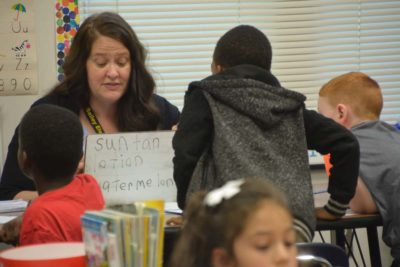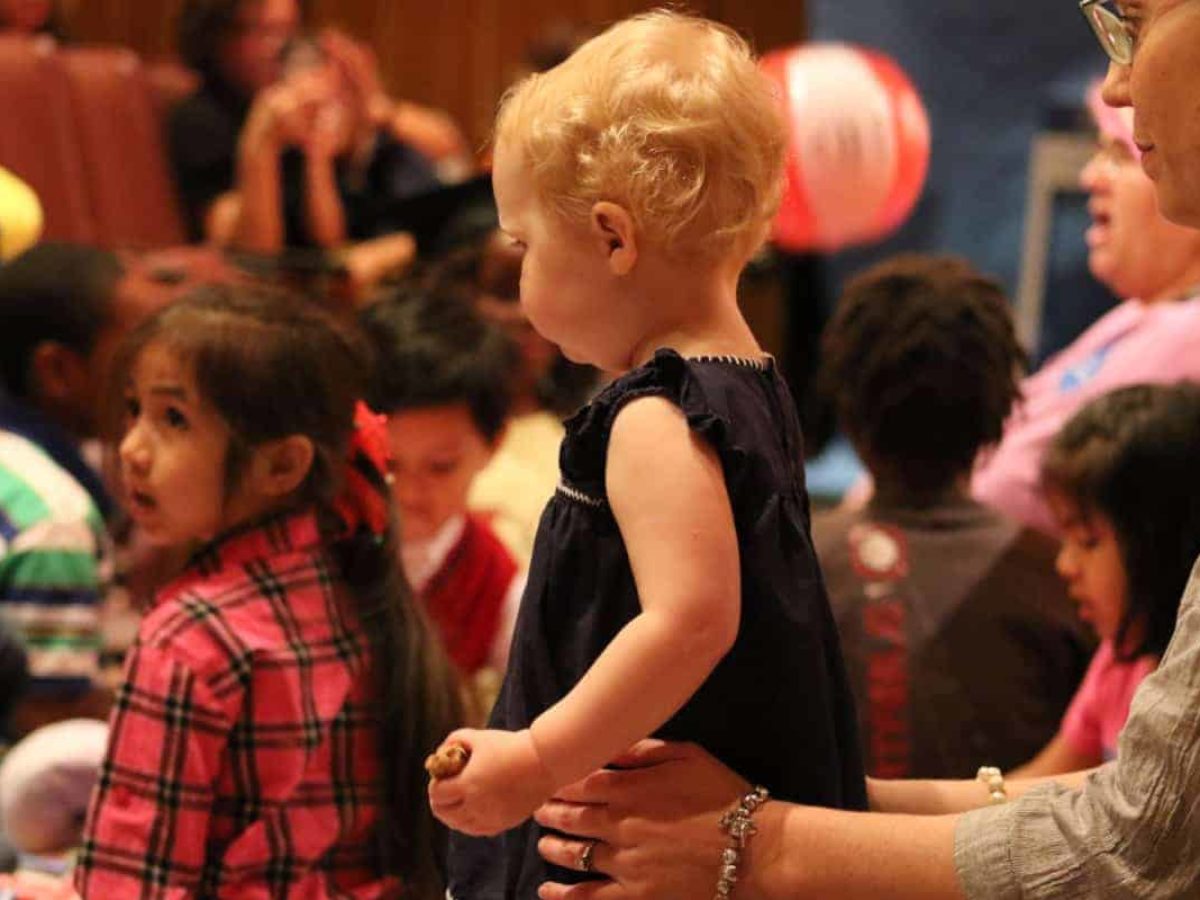

Finding the right child care that meets your child and family needs is important. But finding information on child care options can be tough. In an interview with EdNC.org, Kelly Haight Connor, a press assistant for the Department of Health and Human Services (DHHS), walked through the following steps and tips for using the department’s child care look-up tool.
Start with location
The first screen of the tool offers multiple ways to find child care centers. On this screen, it’s important to remember the stars do not mean those fields are required. If you don’t fill anything out and hit “Submit,” all 5,903 licensed child care facilities across the state will show up. You can begin by inputting whatever information is most useful to you. Connor recommends location (city, county, or zip code) as a good place to start.
If you already know the name of a facility, you can of course start there. The best way to find a facility license number is to ask that specific child care center. Centers are also required to display the license number on its license somewhere at the physical location.
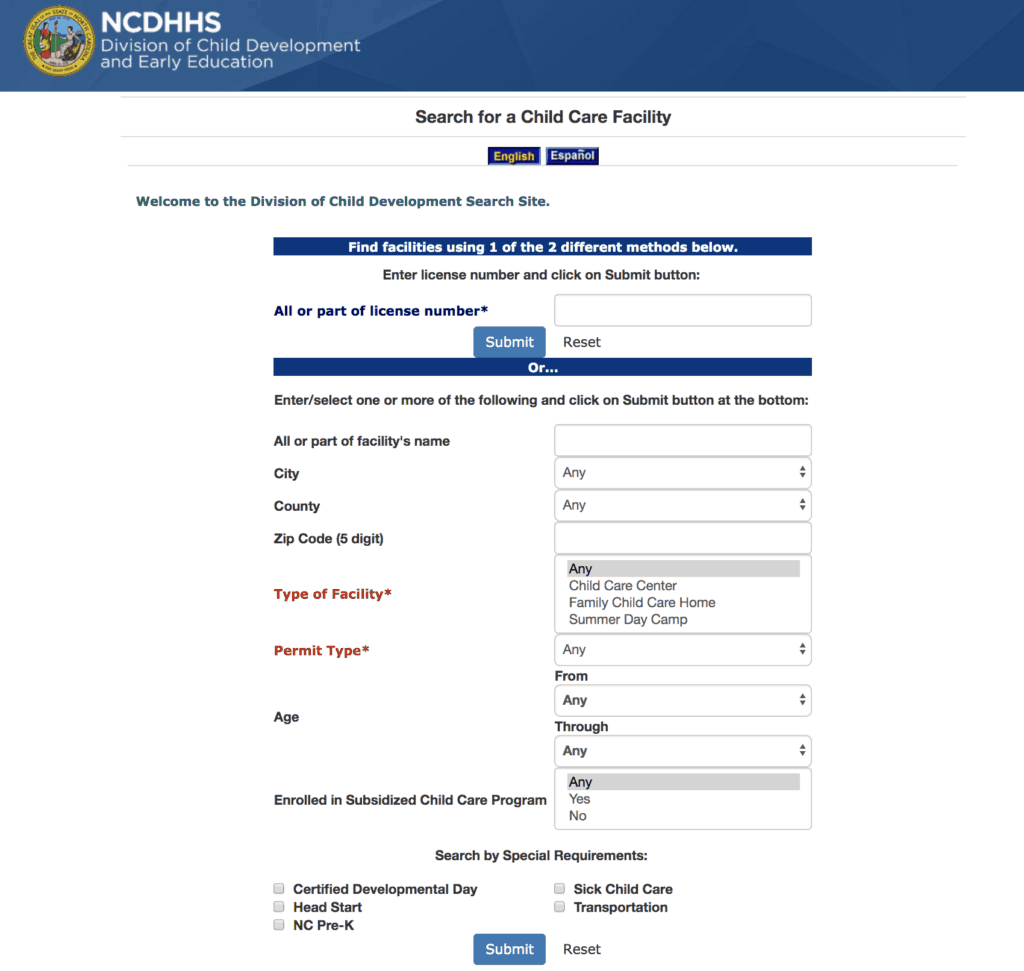

However, if you are at the beginning of your child care search, simply entering a city or county name will bring up every licensed child care facility in that area. Connor also recommends leaving “Permit Type,” which drops down to star licenses or licenses for specific types of facilities, on “Any.” She said selecting a permit type might make you miss an option that works for you. Religious centers, for example, do not have star licenses because they do not have the same staff education standards.
“If I was looking for child care, this one is right near my house and it’s affordable but it only has like a two-star … but this one that’s five-star, I’d be farther away,” Connor said. “So if you’re searching narrowly on that, you might miss one near you or near your commute or near work.”
If you have a preference on whether your child attends a family child care home or a child care center, “Type of Facility” will filter for your preferences. According to the DHHS website, this just depends on what type of setting is best for your child and family. Visiting facilities in person is highly recommended.
The tool can also eliminate any child care options that do not offer subsidized care. More information on child care subsidy eligibility and how to apply can be found here. A Spanish option is available at the top of the page.
Wait, so how are centers licensed?
The child care options that show up in this search are licensed by DHHS’s Division of Child Development and Early Education, and most are rated through a star system. A facility must be licensed if it cares for three or more unrelated children under the age of 13, serves children at least one day per week, and if its services last for more than four but less than 24 hours a day.
Before the star rating is determined, the centers are monitored to meet minimum license requirements. Since 2005, the division has then rated centers from one to five stars based on two factors: staff education and program standards.
How points are calculated and translated into stars is laid out in detail here. Meeting minimum standards gives centers one point. To earn more, centers must meet higher standards like reducing child-staff ratios, scoring at a certain level on the state’s Environmental Rating Scale (ERS) assessment, or requiring staff to complete more credentials or higher education. A total of 15 points can be earned, including one “quality point” based on enhanced education and program standards.
Requirements for certain star licenses in both categories — staff education and program standards — are different for child care centers and family child care homes. As mentioned above, religious centers do not have to meet the same education standards, so they will not have a star license unless they choose to apply.
After the center is licensed, division staff may visit for both announced and unannounced check-ins or support visits. A full list on the kinds of visits staff may make, including if a complaint is filed, can be found here. Staff normally visit once a year for compliance or if the center wants to increase its star license, enroll in the child subsidy program, or become re-certified.
There are also multiple national accreditors for child care centers, like the National Association for the Education of Young Children, the National Child Care Association, and the National Association for Family Child Care. These accreditations do not impact the center’s star license from the state.
Digging into center information
As you sort through the centers listed in alphabetical order, each will have the facility name, contact information, and license type. A variety of information is available for each center. Connor highlighted that each term with an asterisk next to it is hyperlinked to a glossary of terms. Use this for any unfamiliar phrases or for more context on how that term relates to the center’s quality. Use “CTRL+F” on your keyboard to search for specific terms.
The first tab will show basic information on the facility, including its website, its email address, the type of facility, and whether or not the center is enrolled in subsidized care. Identifying information has been blacked out on following screenshots.
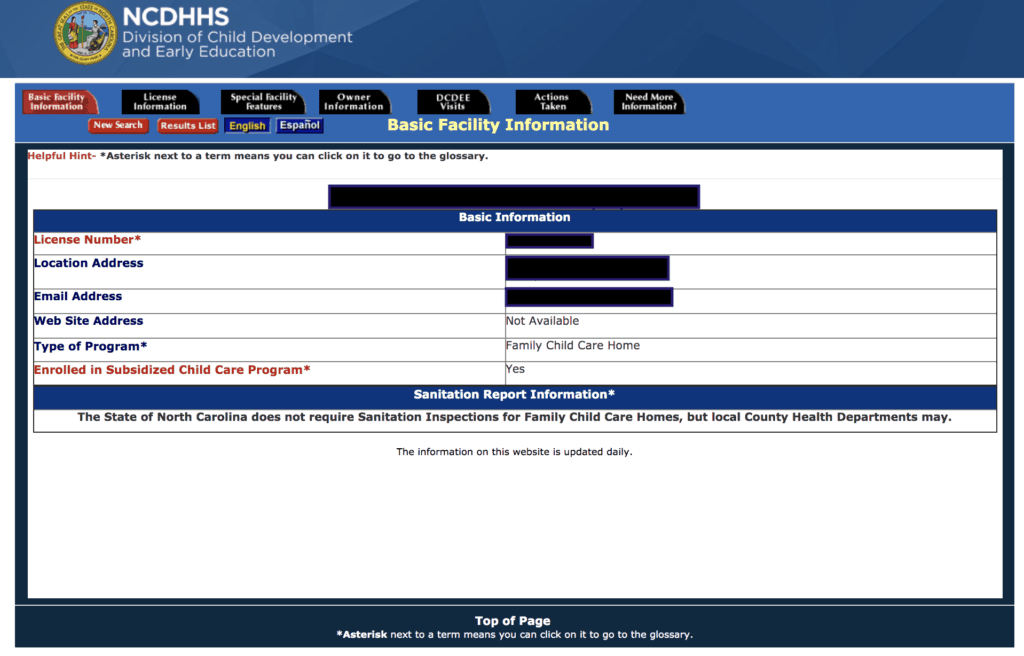

Under the second “License Information” tab, you can see how the center received the star it did and information on both its current and past licenses. Connor said that “Restrictions on License” may sound negative but it is just to outline the center’s provided services. The shifts refer to work shifts and how many children the center is licensed to care for during that time of day.
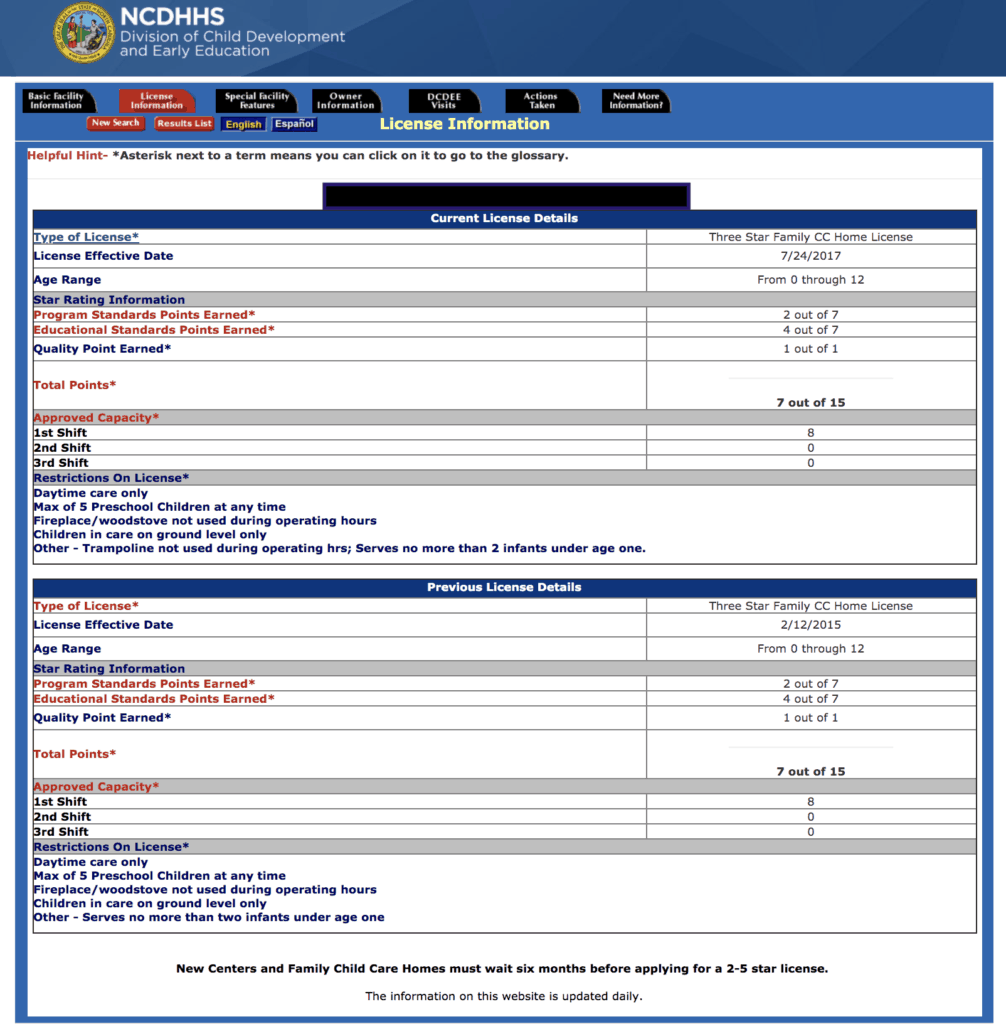

Connor said the third tab, “Special facility features,” might include information like whether the facility can enroll children with special needs or specific staff-to-child ratios. The disclaimer at the top of the page warns that the information may not be up-to-date. Connor recommends reaching out to the facility directly to verify any information under this tab.
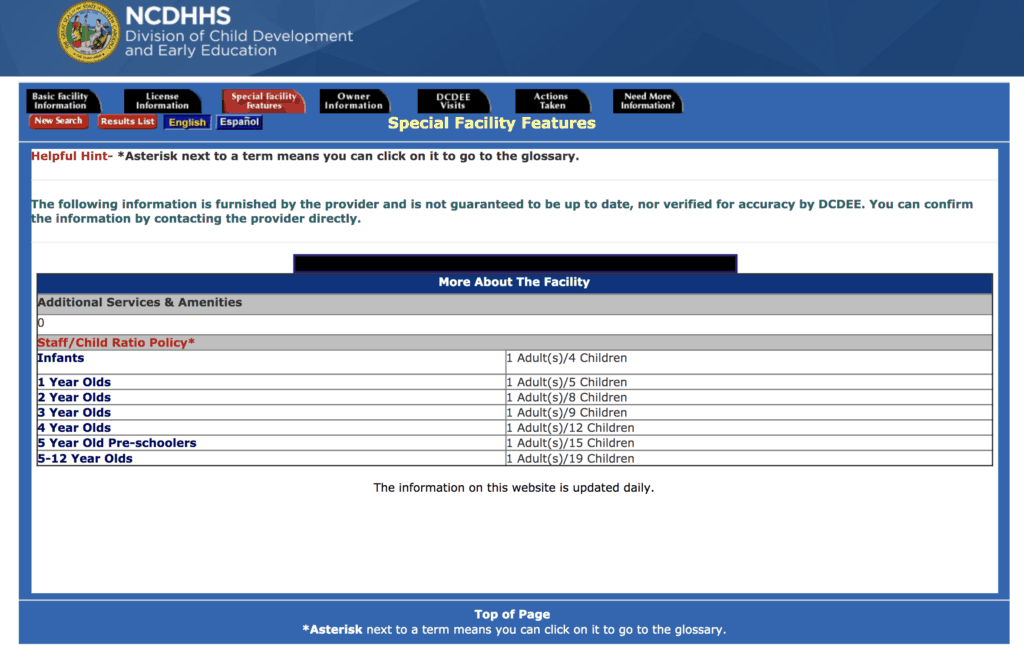

The fourth tab provides contact information on the facility owner, such as address, phone, and email. Under the fifth tab, titled “DCDEE Visits,” you can find information on each visit made by division staff, whether or not the visit was announced, and if there was a violation noted at that visit. The type of visit is hyperlinked and leads to a full visit summary with detailed information on why the visit occurred and what was found. If there are violations, they are also hyperlinked with specifics on what that violation entailed. There will be a note on the timeline of the correction on that same page.
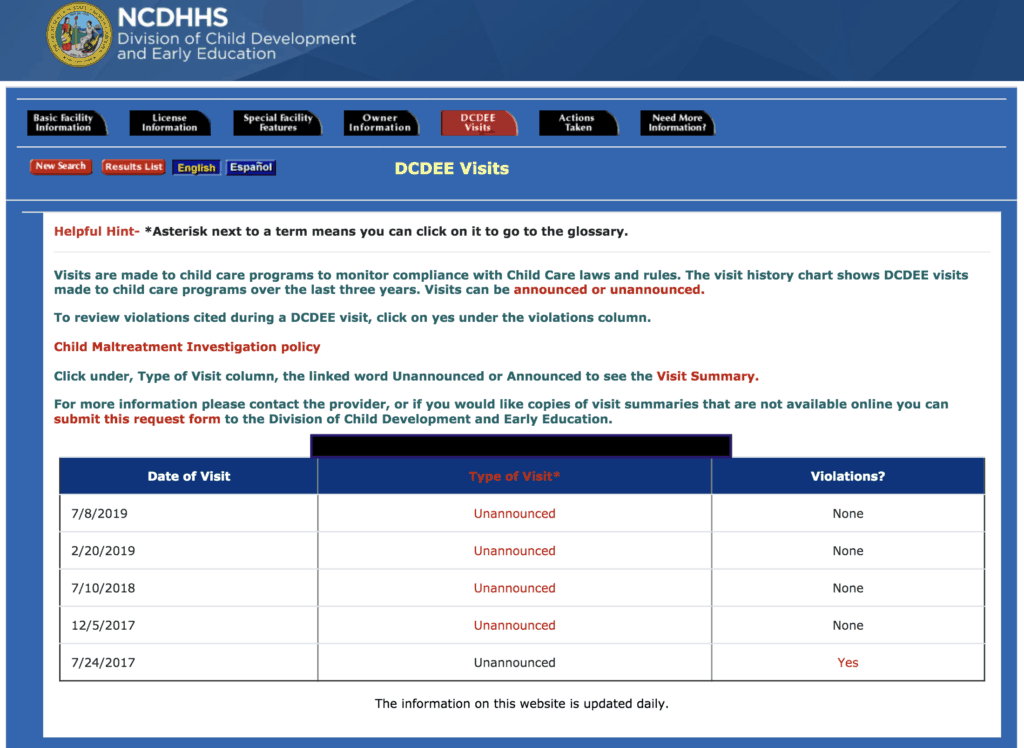

The sixth tab, “Actions taken,” will let you know if any administrative actions have been taken against the facility in the last three years. If so, the site asks you to contact the facility directly for more information or to submit a request form. This request form, Connor said, can be used for any additional information you are seeking that the tool does not provide. Ways to get more information, including the request form, are outlined on the final and seventh tab, “Need More Information?”
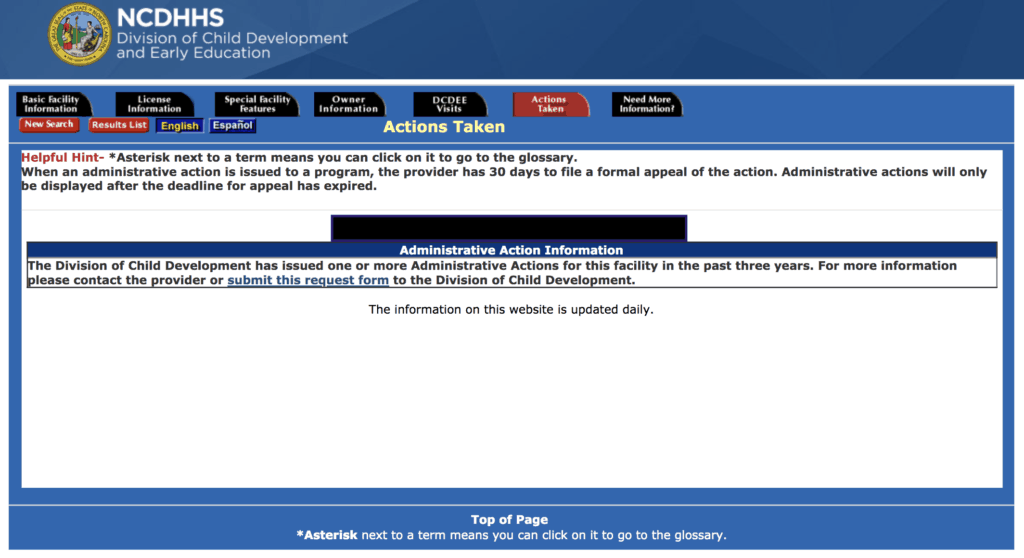

Don’t forget to visit
Connor said the most important part of the search is visiting the facility. DHHS provides checklists for both family child care homes and child care centers that you can use to assess the program. This can be especially useful when visiting and comparing multiple facilities.
The following brochure also provides basic information on child care across the state and local agencies that can provide you with support in your child care search. It recommends visiting at least three centers.


